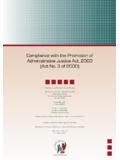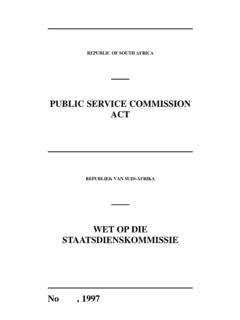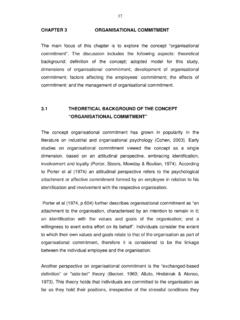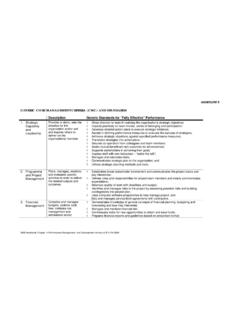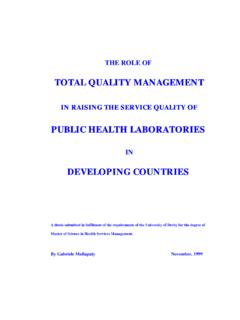Transcription of Chapter 7 Role of Performance Management - …
1 1 Chapter 7 Role of Performance Management The Performance Management and Development System (PMDS) is probably one of the most contested systems implemented in the South African public service. Fundamentally, to conduct a valid and objective assessment of the Performance of individuals constitutes one of the most vexing challenges of human resource Management . Key features of the Performance Management system in South Africa The Senior Management Service (SMS) Performance Management and Development System (the system) is a framework (the broad parameters within which departments must act) issued by the The PMDS is based on assessing Performance during and at the end of a year against a Performance agreement entered into at the beginning of a Performance cycle ( 1 April of each year). It is a framework because the details against which employees are assessed are agreed between an employee and supervisor (and not pre-set by departments themselves).
2 The details that must be filled in are the Key Result Areas (KRAs), outputs and standards against which the employee will be assessed. Core Management Criteria (a list of generic Management competencies) are included to assess the level of competence of employees. During annual Performance assessments staff are scored against the KRAs and standards agreed upon, using a 5-point scale, where 1 and 2 are unacceptable and not fully effective Performance , 3 is fully effective and 4 and 5 are significantly above expectation and outstanding. Scores are moderated by committees to ensure that the same standard is applied throughout the department. To justify scores, staff must provide reports and evidence. Decisions on Performance rewards, the development of staff and dealing with poor Performance are taken on the basis of the assessments. Cash bonuses are awarded only for significantly above expectation and outstanding results.
3 Problem Statement/ Evaluation: At the conference (PSC, 2014) the question was raised whether the problems with the system are fundamental (related to the design of the system) or whether the system is just poorly implemented. Participants agreed that the problems were at both levels. Some of the points below may seem like implementation problems but it can not be expected that a formal (or technocratic) staff assessment system will solve basic Management problems of not setting a clear and unambiguous strategic direction, ambiguousness in Performance expectations, Performance measurement problems at the unit level, poor supervision, and poor accountability for Performance . 1 For levels 1 to 12 each Executive Authority must determine a PMDS for his/her department. For this purpose the DPSA (2007) has developed a pro-forma Employee Performance Management and Development System (EPMDS) as a framework for voluntary use by departments.
4 2 The distinction between fundamental and implementation problems also raises the question of the approach to fixing the system. When some of the problems are fundamental then it can not simply be fixed at the implementation level and if a system is implemented when some of the preconditions for its success are not met, then it can do more harm than good. Fundamental problems The system is a failure as measured against its own objectives Administrative systems should be evaluated against their own objectives. The stated objectives of the PMDS (DPSA, 2007) are to: establish a Performance and learning culture in the public service improve service delivery ensure that all jobholders know and understand what is expected of them promote interaction on Performance between jobholders and their supervisors identify, manage and promote jobholders development needs evaluate Performance fairly and objectively recognise categories of Performance that are fully effective and better manage categories of Performance that are not fully effective and lower No well-designed evaluation has been undertaken to test the effectiveness of the system against these objectives.
5 A key question is: To what extent does the system improve service delivery and evaluate Performance fairly and objectively? The increasing wave of widespread service delivery protests seems to indicate that Performance and service delivery are deteriorating, despite the existence of the PMDS and increased measures to enforce compliance. Measurement problems The PMDS assumes that Performance can be fully and properly evaluated by objective measures. However, in the public service the assessment of many activities requires careful insight and judgement. But even if the belief in measurement is justified, a scrutiny of Performance agreements and work plans shows that the standards mostly do not meet the SMART2 requirements. Outputs and target dates may be specified, but quality very seldom. (See Mintzberg, 1996, for a discussion of the differences between the private and public sectors and different models for Management in government.)
6 A similar thought is illustrated in Albert Einstein s quote: Everything that can be measured is not important [grains of sand in a bucket], and everything that is important, cannot be measured [commitment, insight, judgment]). The system is still much dependent on the subjective judgement of a supervisor and the personal interaction between supervisor and employee. Specifying KRAs, outputs, standards and indicators creates the appearance of scientific measurement, but this is deceiving. Moderating committees are then similarly in the hands of the supervisor and often do not have a solid basis for an assessment. Available evaluations show that one of the main preconditions for the success of the system, namely objective measures, is often not present. At programme and sub-programme level 2 Simple, clear and understandable; Measurable; Achievable and agreed between the member and the supervisor; Realistic within the control of the member, taking account of her/his experience but challenging; and Time-bound.
7 3 (organisational unit level), audits by the auditor-general of pre-determined objectives found that Performance information is often not useful or accurate. Setting Performance indicators on organisational unit level is difficult enough. To isolate the contribution of individuals and set standards at the individual level is even more difficult. Since these are determined between supervisor and subordinate, there is no standardisation of the Performance standards against which employees are assessed. Weak accountability frameworks A prerequisite for effective Performance Management is good accountability frameworks. A proper Management structure requires that responsibility, (delegated) authority and accountability should be aligned as much as possible. Yet the NDP found that in many cases accountability has been eroded: The absence of a process for consequences Management is largely due to the lack of a coherent accountability framework, which links job descriptions and responsibilities, Performance Management and bureaucratic purpose.
8 (NPC, 2011) The National Development Plan distinguishes between two main forms of accountability: (1) The standard hierarchical form where officers are accountable to their supervisors and eventually to the head of department, who is accountable to a minister, the minister to the legislature and the legislature to the electorate. (2) A bottom-up form where citizens hold public officials directly accountable at the level where services are delivered. Both these forms should be strengthened. (NDP, ) The NDP refers to accountability in several chapters. With regard to schools the NDP proposes a framework of results oriented mutual accountability . Districts should be accountable for supporting schools, schools should be accountable to the education authorities as well as the school community and parents should be accountable for the behaviour, attitude, attendance and work ethic of their children.
9 (NDP, p. 311.) With regard to the health system, the NDP found that the Management structure is centralised and top-down with poor authority and feeble accountability. (NDP, p. 332.) It proposes that an appropriately specialised, more accountable Management model for health service delivery, including revised roles and responsibilities for the national department, provinces, districts and public hospitals should be defined. (NDP, p. 336.) It also proposes accountability to users: Governance and Management frameworks, from national to local levels, need to be effective, with the emphasis on accountability to users/ communities. Centralised guidance, technical support and monitoring should be aligned with decentralised, devolved responsibility and decision-making. (NDP, p. 337.) Disjuncture between unit and individual Performance There is currently no scrutiny of individual Performance assessment against the Performance of the organisation/ unit.
10 Objectives are many times determined through a bottom-up approach instead of top-down with departmental leadership setting the Performance expectations. Senior Management should set the tone by incorporating key standards and transformation indicators. Weak 4 departmental planning documents lead to poorly formulated Performance agreements and Performance standards. Lack or poor day-to-day Management of Performance by supervisors including poor supervision, poor people Management , and poor operations Management contributes towards failure of formal Performance assessment A distinction should be made between Performance Management at the organisational unit and individual levels. Performance Management is part of the day-to-day operational Management process (managing the daily work of units). Day-to-day Management of Performance takes place in organisational units and carries on without formal individual staff assessment.





